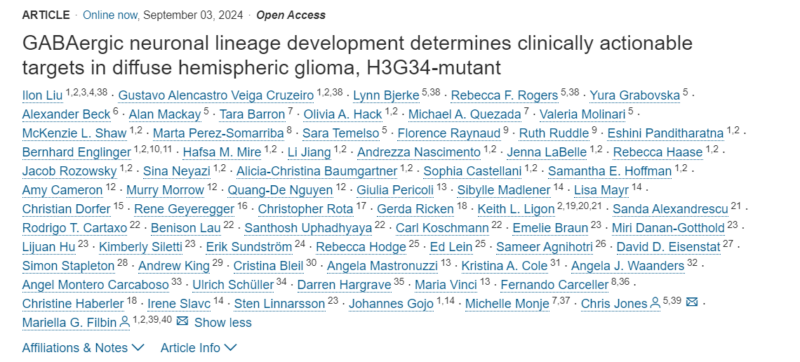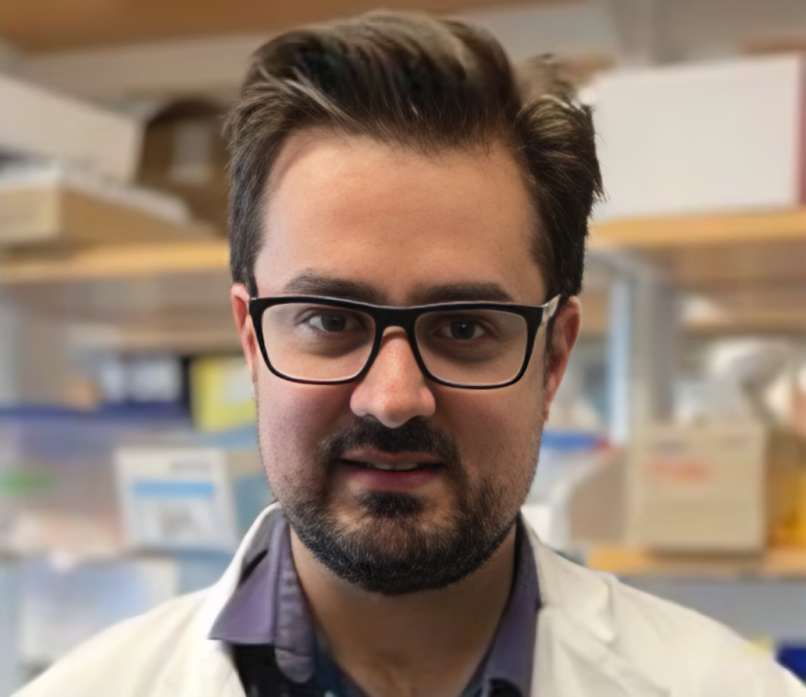Mara Vinci, Chair of Biology SIOPE HGG Working Group, shared a post by Gustavo Alencastro Veiga Cruzeiro on LinkedIn, adding:
“Congratulations Gustavo Alencastro Veiga Cruzeiro, Ilon Liu, Lynn Bjerke, Rebecca Rogers and Mariella Filbin and Chris Jones for the amazing work !!
It has been a pleasure and an honour to contribute!”
Quoting Gustavo Alencastro Veiga Cruzeiro‘s post:
“Our recently published manuscript in Cancer Cell is out – Diffuse hemispheric glioma, H3G34R/V-mutant (H3G34-DHG).
I want to thank all our collaborators, including lab mates at Filbin Lab (Dana-Farber Cancer Institute), Mariella Filbin and Chris Jones lab for always believing in our work with perseverance. I want to extend a special appreciation to our co-leads, Ilon Liu, Lynn Bjerke, and Rebecca Rogers.
Key Insight: H3G34-DHG, a lethal brain tumor, shows similar patterns to developing interneurons.
Findings:
Tumor Origin: H3G34-DHG tumors may derive from interneuronal precursors with GABAergic traces
Cellular Hierarchy: Tumors mimic the spatial organization of progenitor cells in the developing brain.
CRISPR Screens: Identified genes crucial for tumor growth, with CDK6 being a major vulnerability.
Therapeutic Insights:
CDK4/6 Inhibitors and CDK6-Specific Degrader:
- H3G34-DHG tumor cells are more sensitive to these small molecules compared to other pediatric high-grade glioma subtypes.
- Promotes partial differentiation in H3G34-DHG tumor cells, reducing growth and extending survival.
Clinical Impact: We report a refractory patient with DHG-H3G34 experienced 17 months of stable disease on a CDK4/6 inhibitor.
Conclusion: Targeting CDK6 offers a promising new therapeutic avenue for treating H3G34-DHG
A final thanks to the Alex Lemonade Stand Foundation (ALSF) ‘A’ Award and Young Investigator, NIH Innovator Award (DP2), Sontag Foundation for funding this work.”
Authors: Ilon Liu, Gustavo Alencastro Veiga Cruzeiro, Lynn Bjerke, Rebecca F. Rogers, Yura Grabovska, Alexander Beck, Alan Mackay, Tara Barron, Olivia A. Hack, Michael A. Quezada, Valeria Molinari, McKenzie L. Shaw, Marta Perez-Somarriba, Sara Temelso, Florence Raynaud, Ruth Ruddle, Eshini Panditharatna, Bernhard Englinger, Hafsa M. Mire, Li Jiang Andrezza Nascimento, Jenna LaBelle, Rebecca Haase, Jacob Rozowsky, Sina Neyazi, Alicia-Christina Baumgartner, Sophia Castellani, Samantha E. Hoffman, Amy Cameron, Murry Morrow, Quang-De Nguyen, Giulia Pericoli, Sibylle Madlener, Lisa Mayr, Christian Dorfer, Rene Geyeregger, Christopher Rota, Gerda Ricken, Keith L. Ligon, Sanda Alexandrescu, Rodrigo T. Cartaxo, Benison Lau, Santhosh Uphadhyaya, Carl Koschmann, Emelie Braun, Miri Danan-Gotthold, Lijuan Hu, Kimberly Siletti, Erik Sundström, Rebecca Hodge, Ed Lein, Sameer Agnihotri, David D. Eisenstat, Simon Stapleton, Andrew King, Cristina Bleil, Angela Mastronuzzi, Kristina A. Cole, Angela J. Waanders, Angel Montero Carcaboso, Ulrich Schüller, Darren Hargrave, Maria Vinci, Fernando Carceller, Christine Haberler, Irene Slavc, Sten Linnarsson, Johannes Gojo, Michelle Monje, Chris Jones, Mariella G. Filbin

Source: Mara Vinci/LinkedIn and Gustavo Alencastro Veiga Cruzeiro/LinkedIn
Gustavo Alencastro Veiga Cruzeiro is a research fellow at the Dana-Farber Cancer Institute and Broad Institute of MIT and Harvard. He co-founded NEOGENYS Diagnóstico Molecular. He was a research fellow at Harvard Medical School and Massachusetts General Hospital.


